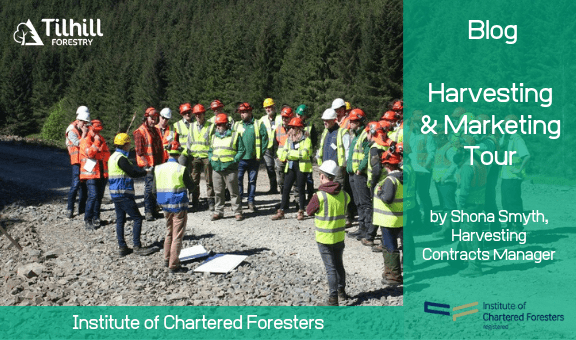Institute of Chartered Foresters
Harvesting and Marketing Study Tour by Shona Smyth, Harvesting Contracts Manager, South Wales
With the recent Harvesting and Marketing Study Tour being the first tour of its kind for the Institute of Chartered Foresters (ICF), I thought I’d share the highlights of the event with all of you. Having only been working in the harvesting sector for the past two years, I was previously a Forest Manager, I can honestly say it is still all relatively new, shiny and exciting and I was looking forward to meeting my fellow harvesting peers from Tilhill Forestry and further afield from both the public and private sector. So, from a sunny South Wales, I headed up the M6 to Dumfries to spend two days in the Scottish Borders.
The two days saw the timber harvesting industry covered with a pretty broad brush; sessions were hosted by Forestry and Land Scotland (formerly Forestry Commission Scotland), Euroforest, EGGER Forestry and James Jones & Sons. The programme covered a wide variety of topics from harvesting, processing and everything in-between. A topic of discussion on everyone’s mind was the impact of disease on harvesting and what’s in store for the future regarding market demand.
Day 1 – Wednesday 22nd May, Study Site 1: Ae Forest
Day One saw the sun shining on Wednesday morning for our first site visit to Ae Forest, just north of Dumfries. The visit was hosted by Neil Murray MICFor, Delivery Manager for Forest & Land Scotland. Ae Forest has been impacted badly by Phytophthora ramorum (larch disease). The scale of the impact was substantial. We had the opportunity to see different management options for dealing with an outbreak, including the felling of a second-rotation mixed crop of Sitka spruce and Japanese larch using a sheer head machine and forwarder extraction for whole tree felling. This was the first time I’d seen this type of operation on a large scale and, given the logistics and potential constraints of harvesting in this way, the main question raised was: ‘Does it pay?’
Study Site 2: Auchenrodden
With the sun still shining on Wednesday afternoon, following a short lunch stop we piled into the minibuses and headed for Auchenrodden Forest near Lockerbie. We met our host Steven Parr, General Manager with Euroforest and had an introduction to the 112ha of harvesting operations on site, consisting of approximately; thinning regimes (5,200m3), windblow clearance (2,200m3) and strip shelterwood systems (2,000m3), before seeing a Komatsu 901XC in action. The site is perfectly located for access to timber markets, so naturally we all began discussing timber valuation processes for the coupe – including again, the effects of larch disease and the pressure it may have on the local markets, given the felling that has taken place here under a Statutory Plant Health Notice (SPHN), but not extracted at the time of felling due to various pressures.
Day 2 – Thursday 23rd May
Study Site 3: Ewelairs
Following a pretty packed itinerary yesterday and a good chance for networking over dinner in the evening, it was time to get back into the minibuses and head for Ewelairs near Moffat. The coupe is part of a wider forest complex, but covers an area of 42ha and has produced 20,000 tonnes of timber so far. Having worked on some large scale felling programmes in Wales I didn’t think much would surprise me, but the scale of the complex and the distance to get into the forest once turning off the main road was mind boggling!
It was a bit of light relief to not be discussing tree disease and swap to forest infrastructure and access. The access arrangements for this block were interesting given the ownership structure, with a new section of forest road constructed to gain access across the adjoining farmland. This led to discussions around public engagement and its importance with large scale felling and infrastructure projects. Also, with the high public profile, the importance of health and safety on site.
Making the most of the sun shining at Ewelairs
Study Site 4: James Jones & Sons, Sawmill
The final stop of the trip was the highlight of the event for me, a tour of James Jones & Sons Sawmill at Lockerbie, fully completed in 2009. The tour was led by Euan Borthwick, Harvesting Manager for James Jones & Sons. This sawmill is considered one of the most technological advanced sawmills in Europe, so it was fantastic to see the three mills on site in operation, suitably named Lockerbie I, II and III. There was a wide variety of machinery too…., including a profile sawline, grader and planer and handling and stacking systems producing a wide product range including; KD C16 carcassing, pallet boards bearers and block, fencing, landscape sleepers, boarding and economy grade. Additionally, there is value added (though we didn’t get to see this due to time constraints) including; kilning, planning and green and brown treatment.
The log yard at James Jones & Sons Sawmill, Lockerbie
After a packed couple of days it was time to get on the road back to South Wales. The event was informative, interesting and gave plenty of opportunity for discussion and sharing of ideas. It was motivating to discuss different approaches companies have to management decisions and scenarios. I would recommend for anyone looking at coming into the harvesting sector to attend an event like this, to meet new and experienced professionals and gain an idea and understanding of the sector, it’s dynamic and exciting to be a part of – and not all about felling trees (as often perceived!), it’s much more than that.
A well-attended ICF Harvesting and Marketing Study Tour 2019
For more information on the ICF and upcoming events visit: https://www.charteredforesters.org/
by Shona Smyth
Harvesting Contracts Manager, South Wales






